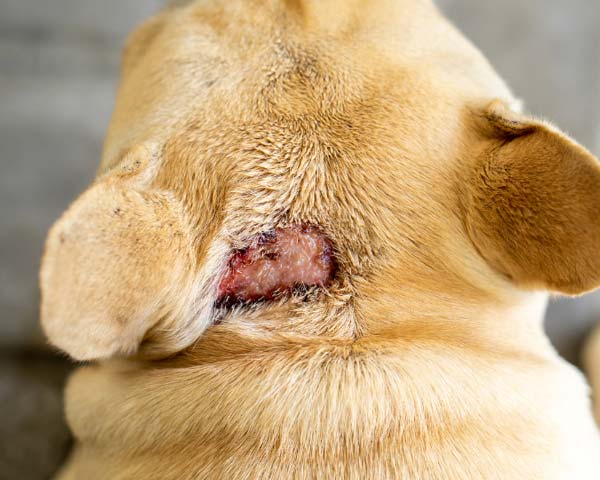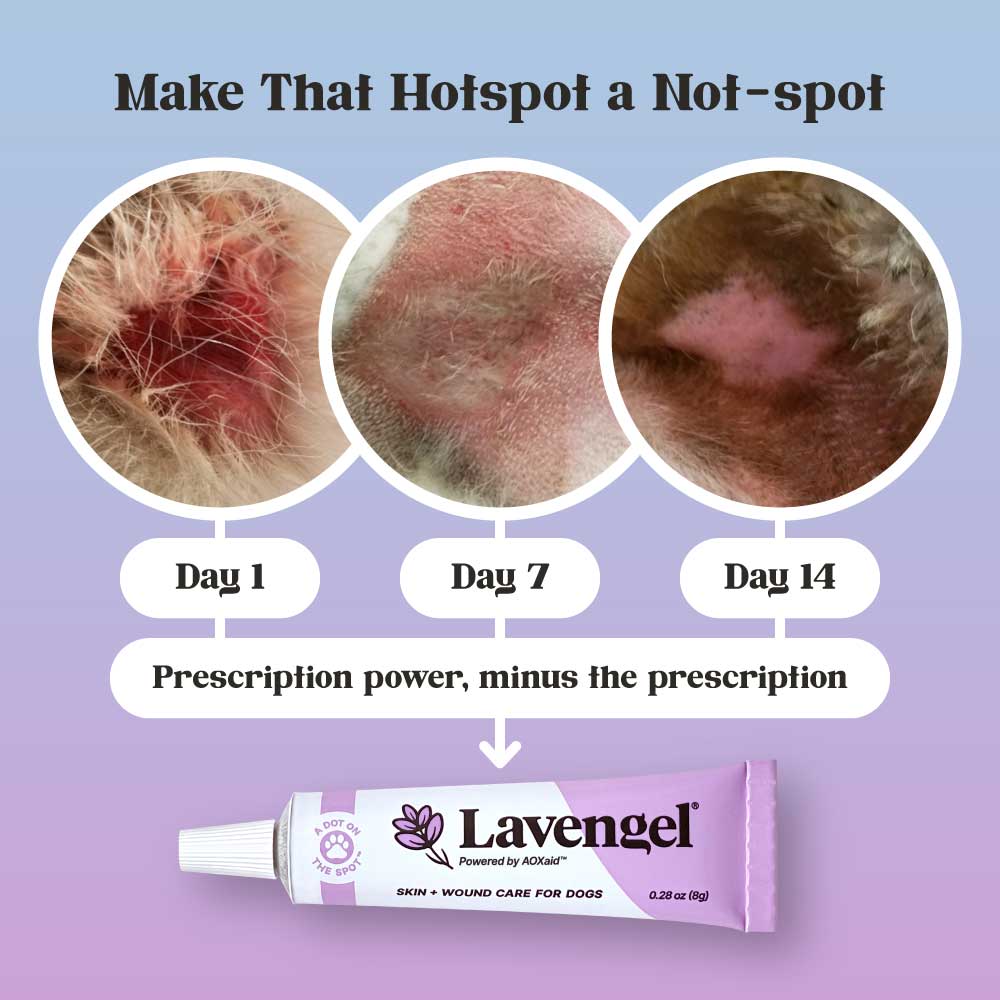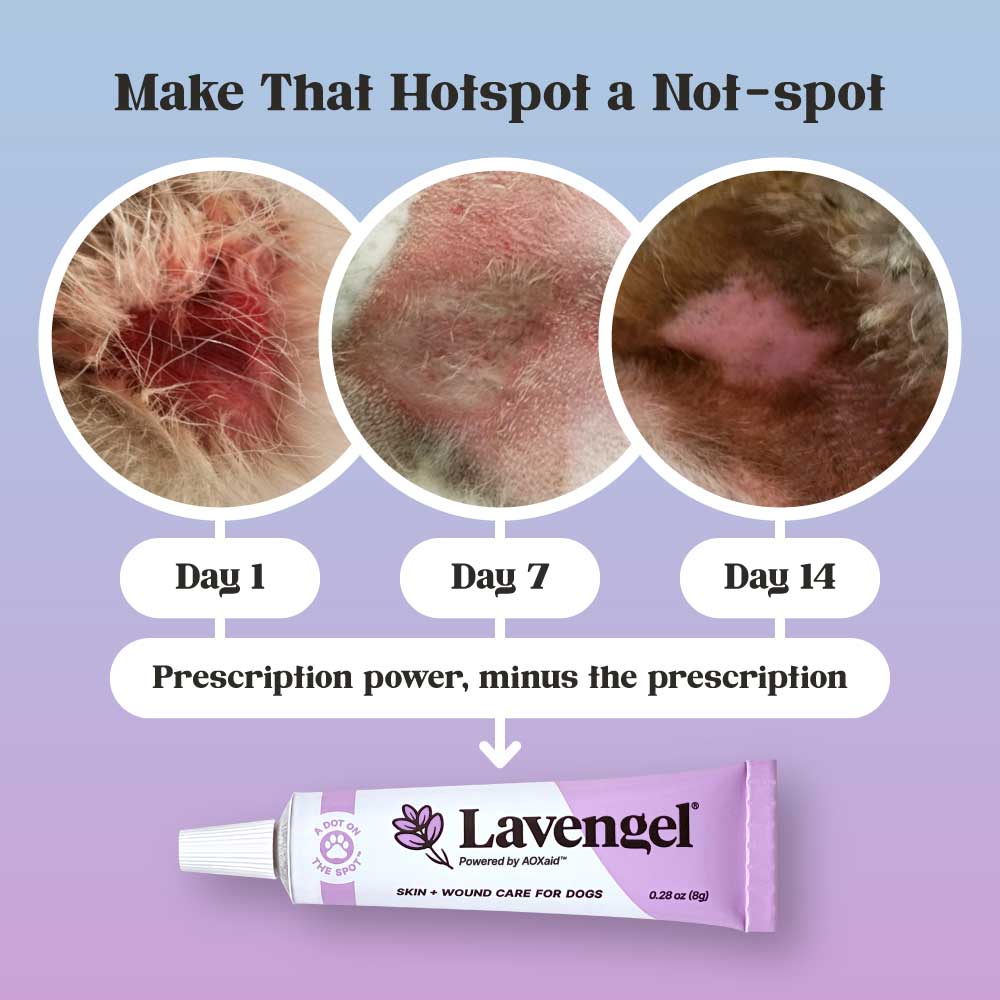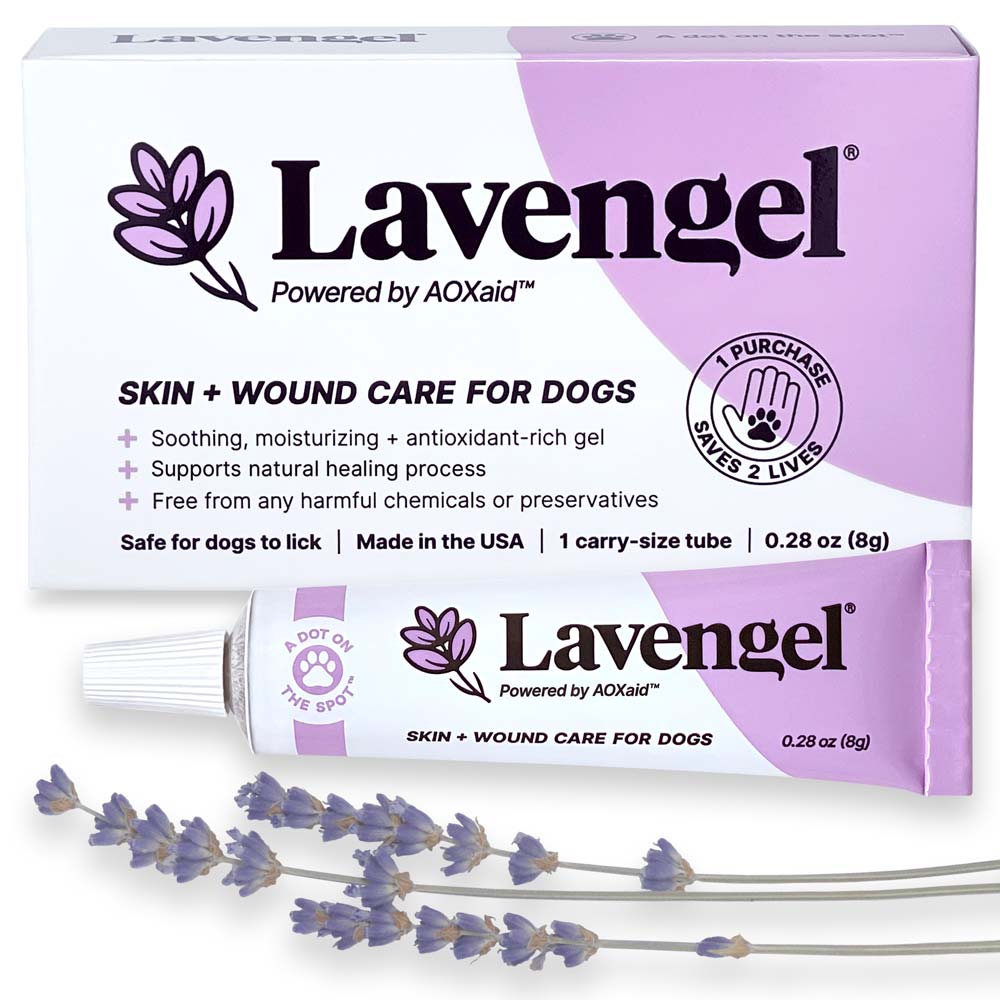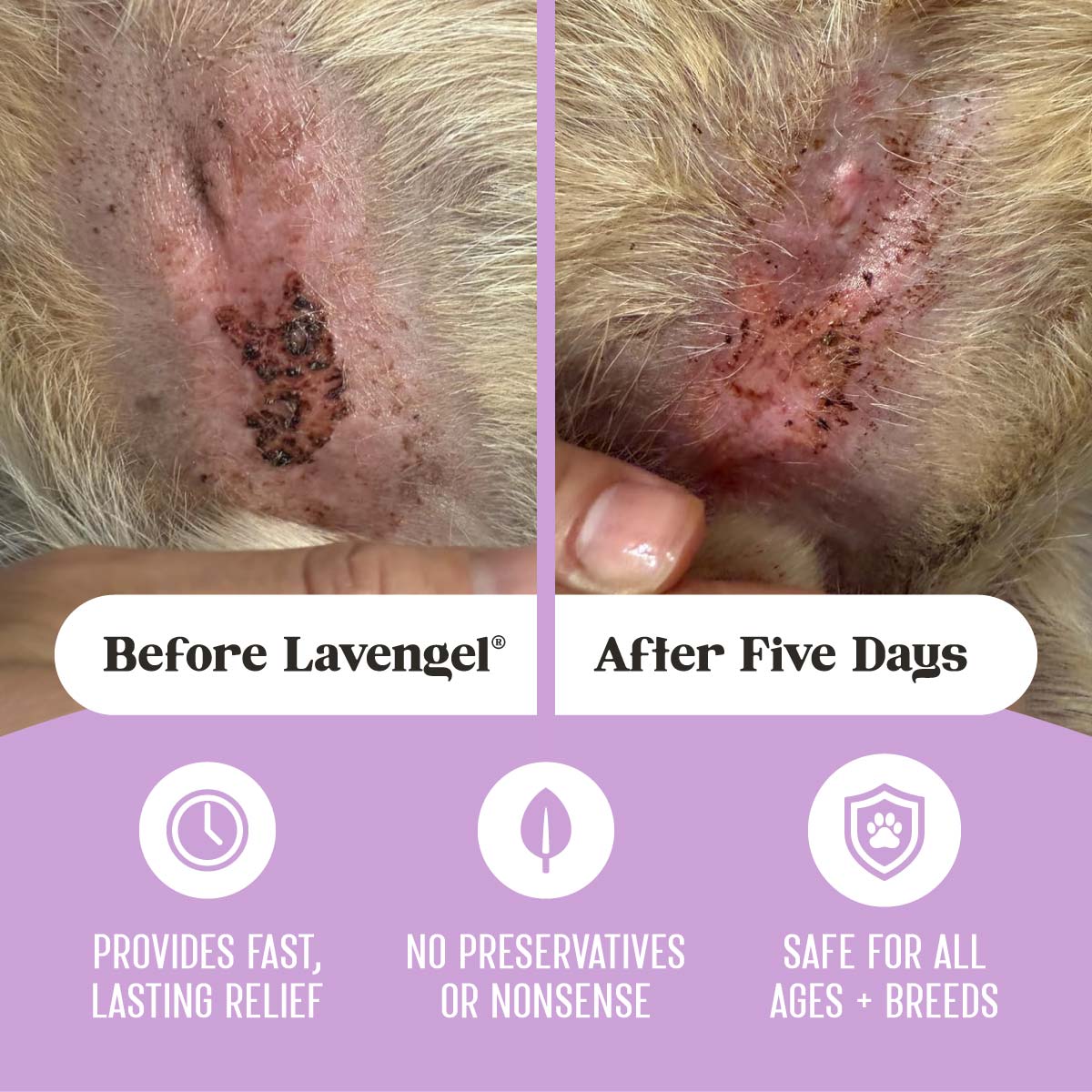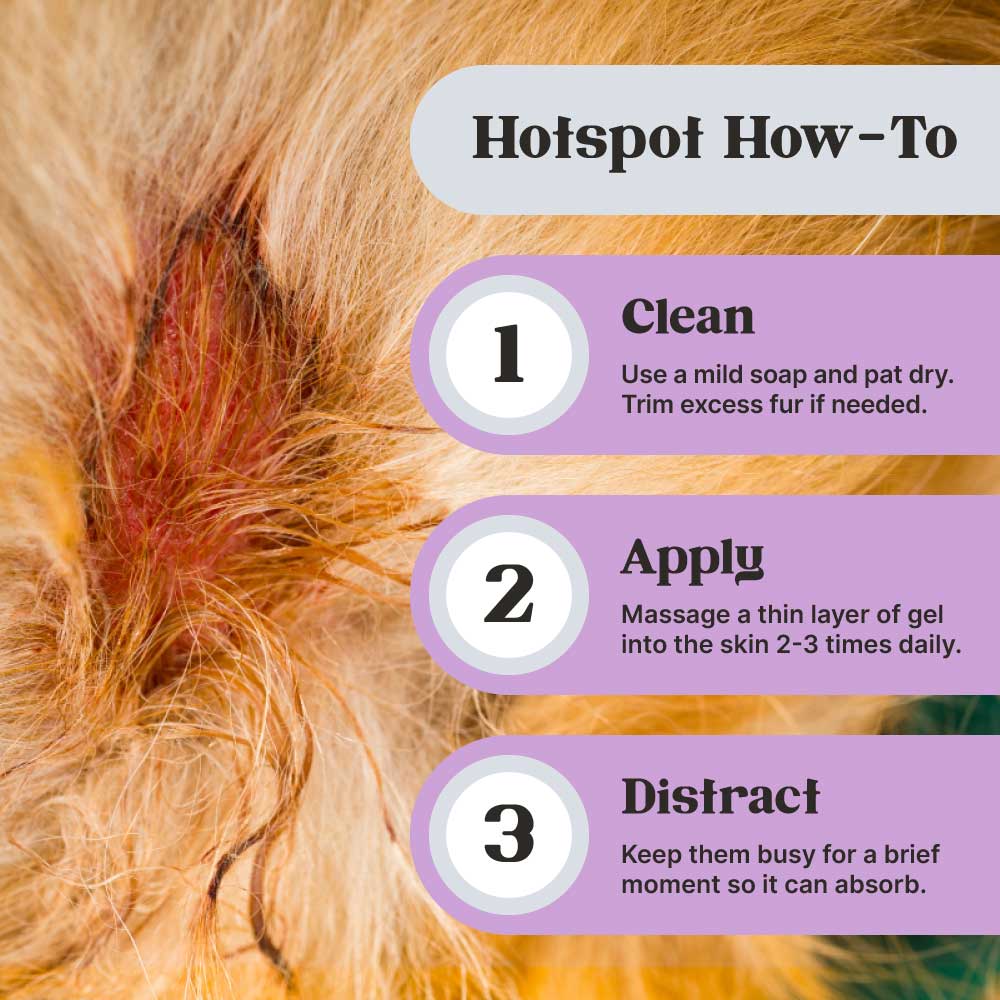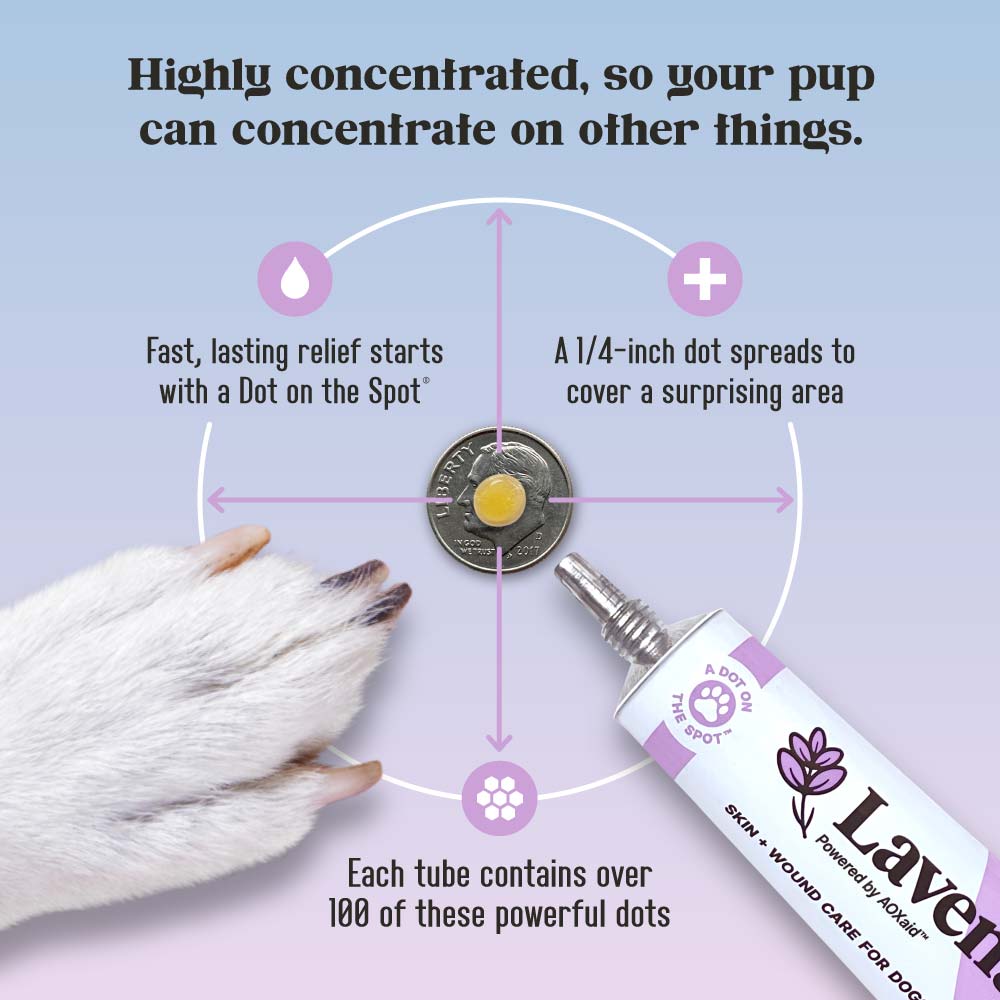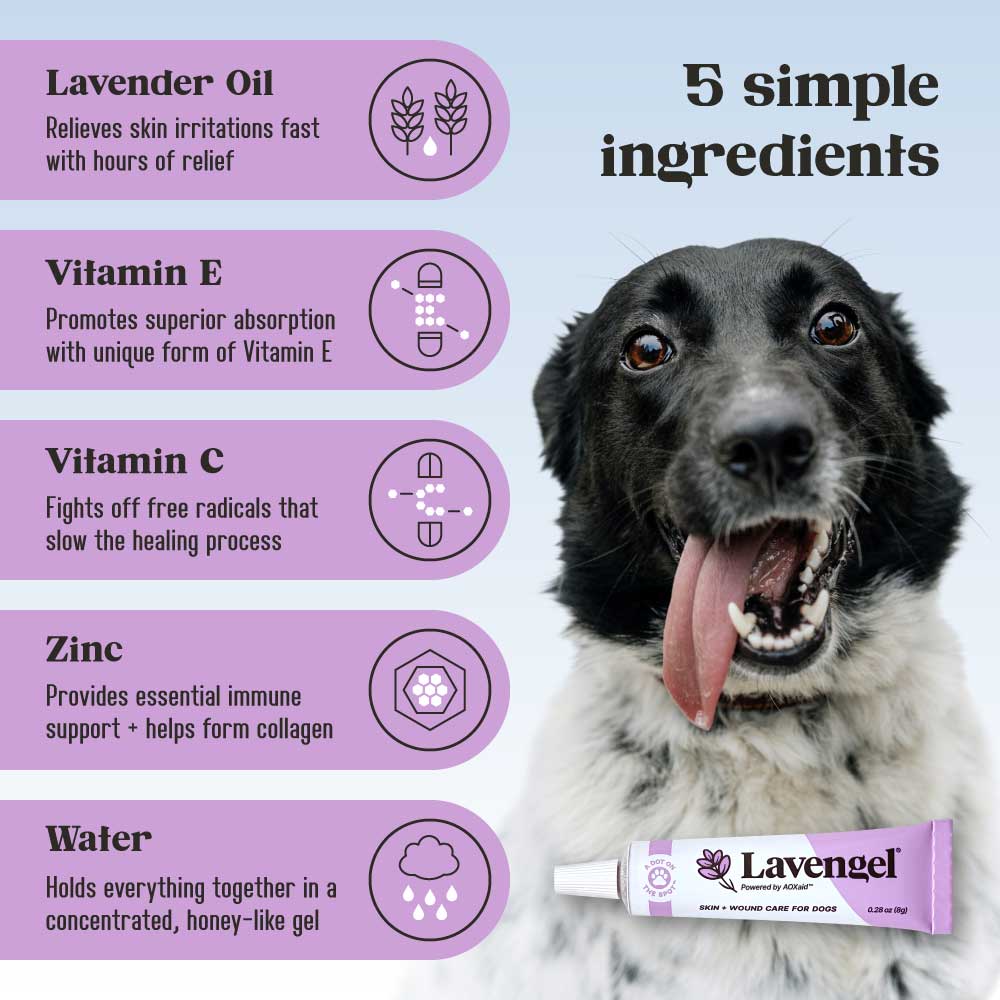September and pumpkin spice lattes are here! Falling leaves, sweater weather, and…allergies. In veterinary medicine, we often see pets coming in for excessive licking, tummy rashes, and other allergy symptoms.
Following closely behind these is another common condition known as the canine hotspot. These ugly sores can hide beneath your pet’s fur and grow to alarming sizes before being noticed.

Before/after of an extensive hot spot rash on a rescue dog (Samson) that was treated with Lavengel. You can about his case and others on our Real Stories page.
Recognizing a Hot Spot on Your Dog
So, what exactly is a canine hot spot? Hot spots are known as pyotraumatic dermatitis or acute moist dermatitis. This skin condition occurs mainly in response to excessive irritations in a specific area of your pet’s body.
These are most commonly found around the head, neck, and the hips/tail. Hot spots can be identified by a few key characteristics:
- Red and inflamed area of skin.
- Skin appears to be raw and ‘angry.’
- Pus or discharge may be present.
- The fur around the area may be matted or missing.
- There is scabbing in and around the area.
- Your pet seems to be painful around this area.

Photo: Acute moist dermatitis on dog's leg, via r/holoVII on Reddit
How Can I Prevent Hot Spots on My Dog?
You're probably saying, "Wow, that sounds awful. How do I prevent this from happening to my dog?"
Great question. Hot spots are the result of damaged skin that is typically caused by your dog's repetitive scratching and licking at itchy skin.
Itchy skin can come from prolonged moisture (especially on those summer days when water is our friend), fleas, skin allergies, or areas of increased contact - like from a collar, harness, or even skin folds. The excessive scratching, rubbing, and chewing inflames the area and makes it worse, eventually creating the dreaded hotspot.
Here are a few ways to stay one step ahead of pesky problem areas that can potentially progress into hotspots:
Reduce Moisture
Make sure your dog is completely dry after baths. Prolonged areas of moisture can be a breeding ground for yeast and bacteria that can be quite itchy.

Flea and Tick Prevention
A flea/heart worm prevention routine should be a no brainer for any pet owner. A common myth is that your pet does not need flea prevention in the fall and winter months as temperatures drop.
This is far from the truth. Your pet can still carry fleas, especially inside your home where temperatures are nice and toasty.
There are several great preventative medications, including Bravecto® Chewables, Advantage® Multi, Seresto®, and more.
These products are designed to be safe for you and your pet while providing protection against fleas. As a bonus, many even have off-label benefits (meaning that they are not specifically prescribed for something) that can prevent or kill ear mites, walking dandruff (Cheyletiella) mites, and mange mites!
Talk to your veterinarian about the best option for your pet to keep them protected.
Mitigate Skin Allergies
Skin allergies are super common in dogs, especially in the spring and fall. They suffer from seasonal allergies as well as food allergies that can cause super itchy skin. As the desire to scratch increases, so does the need to lick and chew their itchy skin!
The typical first line of treatment for your pets’ seasonal allergies is an antihistamine oral regimen (food-based allergies are a different story for a different blog 😉). However, if this doesn’t provide effective relief for those extra itchy guys, talk to your veterinarian about beefing up your anti-itch arsenal.

Photo: Acute moist dermatitis on Golden Retriever neck under collar, via r/Jaded-Trick7939 on Reddit
Check Collar and Harness Tightness
This area ties in with our first point as well. It’s common to see hot spots develop underneath collars and harnesses as this point of contact does not allow moisture to escape nor appropriate airflow for it to dry - especially after swimming or on humid days.
Be sure to remove your pet’s collar frequently, check for wet areas, adjust sizing (you should be able to fit two fingers under your pet’s collar at all times), and allow the skin to breathe.
Watch for Excessive Itching
If your pet is scratching or chewing more than usual, be sure to inspect the area right away. It is easy to forget flea prevention, fail to notice a bee sting, or to dry your pet after a frolic in the yard sprinkler. Being mindful of normal behaviors will allow you to be more alert to when an unusual problem arises.
If your pet is licking/chewing an area that is becoming red and inflamed, try to deter them from the area. The more they disturb the skin, the itchier it gets! You can use a t-shirt or sock to cover the area, or in some cases a “cone of shame” may be needed to keep your pet from chewing.
Regular Grooming and Hair Trim
Give dogs with thick or long hair a trim for the summer and fall seasons. This will allow more air to reach the skin. And don’t worry, your pet’s hair should be growing in for the winter months without any issue!

Photo: Facial intertrigo (skin fold dermatitis) on French bulldog, via r/ADM1277 on Reddit
Keep Skin Folds Clean and Clear
If you've got a wrinkly breed, be sure to keep those folds clean! In the same way that tight collars and harnesses trap moisture in the fur and don't allow proper air flow, those cute and squish-able wrinkles do the exact same thing.
As adorable as they are, skin folds are easily irritated and commonly develop a form of dermatitis called intertrigo - as well as acute moist dermatitis. On top of that, they make prime locations for microbes to get set up and create bacterial and yeast infections.
What’s the Treatment for Hot Spots?
Okay, so you’re enjoying your warm pumpkin spice latte, and Rover has been driving you nuts with super itchy skin. You check out what all the fuss is about, and now you notice an angry inflamed sore on his back that seemingly grew overnight! What do you do?

Progression of hotspot on the belly of a husky (Kierra) treated with Lavengel®. You can read about her case and others on our Real Stories page.
Determine Location, Size, and Severity
Try to figure out the location, size, and severity of the area. Hot spots can hide under dense coats and "covered" areas, so check to see where the margin of the area stops.
Note: Hot spots can be quite painful. Be careful when handling your pet! If your pet is too painful, skip the first step!
Apply Lavengel® to the Hot Spot
Put some Lavengel® on it! Lavengel® has been shown to decrease irritation and inflammation, reduce or eradicate bacterial burden (i.e., it’s antibacterial), and stimulate wound healing through collagen formation.
Although Lavengel® is safe for your dog, if they are still licking the area, it’s best to try and reduce their access to the area for several minutes after application. This gives Lavengel® time to work its magic and reduce the need to scratch!

Before/after comparison of a hot spot with black scabbing on a dog's belly, after 5 days of using Lavengel®.
Consult with Your Vet
Call your veterinarian to have your pet’s skin checked. If the hot spot on your pet looks severe or is recurring after treatment, it is definitely recommended to see you regular veterinarian. In these cases, avoid using any OTC antimicrobial products before being seen.
Your pet’s doctor may recommend taking a bacterial sample to culture. This will help evaluate what pesky bug is causing a recurring problem for your pet and allow for the selection of an appropriate and effective antibiotic treatment.
Using OTC medication may alter these results. A more aggressive treatment may be necessary for a recurring skin problem.
Deeper Dive: What Makes Lavengel® Great for Hot Spots
Why do we recommend Lavengel® for your dog’s sneaky hotspot? It’s because Lavengel® has been clinically shown to reduce pain and inflammation, bacterial burden, and help your pet’s skin to heal quickly.
Once the skin barrier has been disrupted, the bacteria can begin to proliferate, or grow, causing a superficial infection - often referred to as pyoderma. The most common bacterial strain in canine hot spots and wounds is Staphylococcus pseudintermedius - a cousin of Staphylococcus aureus that affects humans.

Live fluorescent dye assay (test) of Staphylococcus pseudintermedius with and without 8% Lavengel®. Each bright green dot represents a live colony of bacteria, with an enormous difference between the control and Lavengel® groups.
This strain is commonly found on the skin and in the mouth of cats and dogs, and it is usually harmless to your pet (and you, so don’t worry about those puppy kisses). As the skin gets increasingly damaged, you may see pus, loss of fur, and eventually a foul odor coming from the area.
Many times, the bacteria in acute moist dermatitis infections can form biofilms (you can learn about these in our Biofilms post). These biofilms serve as a protective layer to the bacteria that live beneath them, acting as a shield to many topical antimicrobial products.
This is where Lavengel® shines! Lavengel® has the ability to break down and penetrate many types of biofilms to kill the bacteria harbored there. It even has a U.S. patent for its effectiveness against Staph bacteria - including methicillin-resistant Staphylococcus pseudintermedius (MRSP) and methicillin-resistant Staphylococcus aureus (MRSA)!
No one wants to see their pet suffering with an annoying and painful skin condition. Lavengel® is a topical product that you can have on hand to treat all sorts of cuts, scrapes, and abrasions at home. Hotspots can be added to that list!
-
**Friendly Disclaimer: Please seek medical treatment for your pet if at any time you are concerned about an uncontrolled infection, injury, or medication. This blog does not substitute for medical advice from your veterinarian.
